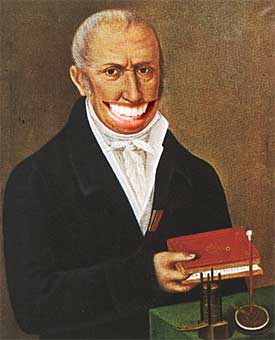Alessandro Volta
With almost every aspect of modern devices made possible by technology
based on his invention in 1800, it is surprising that Alessandro
Volta is not a recognizably common name.
|
|
 Alessandro Volta
Alessandro Volta |
Who would have believed that those small batteries which power
our cellphones, laptops and tablet devices are the great, great
grandchild of an invention from the Georgian Era? It was Volta's
creation of a Voltaic Pile, which was a forerunner for the modern
battery which managed to revolutionize electronics.
Alessandro Volta was born in Como, Italy in 1745 and was educated
in the local public schools. He spent the bulk of his career as
a scientist, working as a professor of physics at the Royal School
in Como and later at the University of Pavia, while continuing
to study the properties of electricity.
In 1775, he invented a device which could produce a static charge
called the electrophorus, before discovering methane in 1777,
through his studies of the chemistry of certain gases. Both these
scientific breakthroughs were merely paving the way for his revolutionary
invention of the Voltaic Pile in 1800. The voltaic pile was in
essence the world's very first battery as it could provide a continual
electric current to a circuit.
Volta built his invention based on a discovery made by Luigi
Galvani in the 1780's. Galvani discovered that a circuit of two
metals connected to a frog's leg could cause the leg to respond.
Volta took this information to the next level of discovery by
stacking metal discs in alternating pairs of copper or silver
and zinc with cloth soaked in a brine solution between them. When
he connected a wire to the top and bottom contacts, an electrical
current flowed through it.
This invention paved the way for a cascade of new discoveries
beginning with electrolysis, which was used to separate water
into the elements of hydrogen and oxygen, and then allowed scientists
to isolate the chemical elements of sodium and potassium in 1807,
calcium, boron, barium, strontium and magnesium in 1808.
Volta's invention was so groundbreaking that Napoleon recognized
his contribution to science with the title of Count in 1810 and
the entirety of the electrical industry of the 19th century was
supplied power by batteries closely related to Volta's original
designs until the invention of the dynamo in the 1870's.
Alessandro Volta retired from academics, inventing and teaching
in 1819 and spent his last years at his estate in Camnago, which
was renamed Camnago Volta in honor of his achievements. He died
there in 1827. His legacy is still recognized today as a museum
built to be dedicated to his works still exhibits some of his
original experiment equipment and a foundation promoting scientific
discoveries and activities was also named in his honor.
Even those of us who have never heard his name make reference
to him every day, as the term volt was named in his honor in 1881.
We still refer to the measurement of electromotive force using
the term volts as you will see on any electrical appliance you
may have in your home today.
Rumor Has It …
Rumor has it that besides the accurate biography presented above,
Alessandro Volta used to drive a Chevy Volt to market in order
to buy frogs legs. Once at the market, he would whip out his invention
and make the frogs "dance" for the crowd.
Written by Kevin Lepton
|

